
|
Today's Calendar |
| | Simply Economics |
| | International Perspective |
| | Resource Center |
 |
|
| 1999 Articles |
|
By Evelina M. Tainer Chief Economist, Econoday November PPI friendly for markets
If the weekly change is positive, it must be the NASDAQ 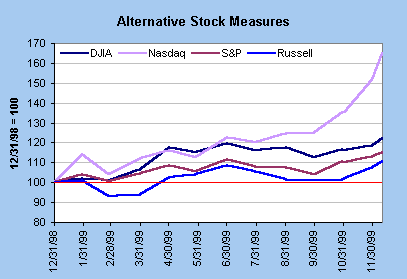 But the NASDAQ composite is at stratospheric levels. Most analysts are expected near term corrections in this market. Yet, many talking heads this past couple of weeks have indicated that the soaring market is fueled by an early "January effect." With just a couple of weeks to go before yearend, the NASDAQ has jumped 65 percent this year! It makes the rest of the market indices look paltry. Yet, given the double-digit gains of the past few years, even the "moderate" increases in the Dow and the S&P should be considered good.
Treasury yields dip 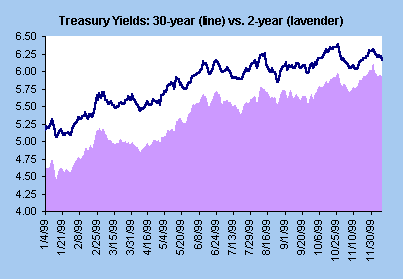
Energy prices rise but core PPI unchanged 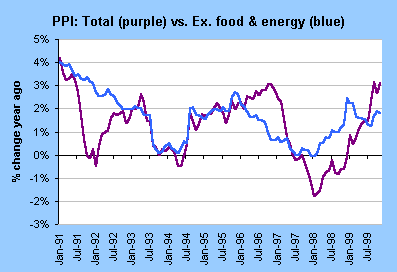 Many financial market participants also look to the PPI for crude materials and intermediate goods to see if inflation is accelerating in the pipeline. Actually, the intermediate goods index is also up 3 percent from a year ago; and excluding food and energy products, it is up 1.5 percent. Crude materials are up more dramatically. The total index is up 16 percent from last November. Even excluding food and energy products, the index is 9.7 higher than a year ago. It appears that producers are taking the higher costs in lower profit margins, rather than raise prices in this competitive environment. The Labor Department also reported import and export prices earlier this week. Export prices were up only modestly, but import prices rose more dramatically because of higher energy costs. Note the sharp climb in the yearly import price index in the chart below. Even export prices are over the zero mark. 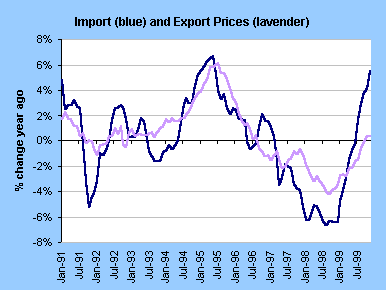 The bottom-line on inflation? Energy prices are clearly boosting all price indices. Yet, even after removing this volatile component, prices are somewhat higher than a year ago. Based on the sharp distinction between the PPI for finished goods and the PPI for crude materials, it does seem that producers are very leery about raising prices for their customers. Inflation may be a factor that causes the Fed to raise rates early next year, but this week's set of data aren't foreboding.
Productivity gains robust 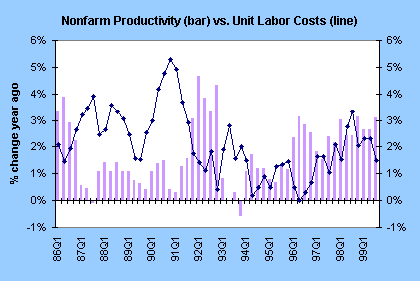 Unit labor costs decreased at a 0.2 percent rate in the third quarter, a slight downward revision from the initial estimate. On a year-over-year basis, unit labor costs were up 1.5 percent. This is also a reduction over the past several quarters. The bottom-line on productivity? Productivity has increased at a healthy rate in this expansion. Indeed, the gains we have experienced in the past couple of years are larger than usual for this mature stage of the business cycle. Productivity gains have allowed accelerated wage gains without the problem of inflationary pressures. No one disputes that the productivity gains of the past few years have exceeded expectations and have helped contain inflationary pressures. The question now -- debate really -- is whether productivity growth can continue at the pace we have seen. Most policy-makers, including Fed chairman Alan Greenspan aren't so sure that current productivity gains are sustainable. If productivity begins to grow more slowly in coming months, it will mean that wage hikes could develop into consumer price inflation. It is important to realize, though, that the debate is ongoing. These are uncharted waters for policymakers -- and economic forecasters -- to some degree.
Consumer credit growth moderates 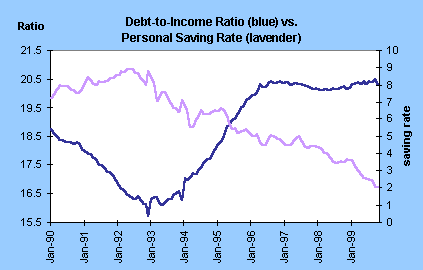 The bottom-line on credit? Consumer spending is fueled by income, stock and housing appreciation. This means that consumers are borrowing more and saving less. In a robust economic environment, that isn't necessarily a problem. But should some factor from out of the blue cause income to moderate or the market to drop sharply, consumers won't have much of a rainy day fund.
THE BOTTOM LINE The likelihood of a change in interest rates at the December meeting is virtually nil. Yet, Fed officials may debate the benefits of re-instituting a bias towards tightening. When they raised rates last month, they had shifted policy back to neutral. A tightening bias would indicate to financial market players that Fed officials were on serious alert and monitoring closely the booming economy (which is growing faster than the potential no matter who measures potential!)
Looking Ahead: Week of December 13 to December 17
Tuesday Economists are predicting that retail sales will increase 0.5 percent in November - better than the October pace which reflected no growth for the month. Excluding the auto group, retail sales could rise 0.4 percent, just a tad less than the previous month's gain of 0.5 percent. Remember that retail inflation is virtually nonexistent. This means that current dollar gains are nearly the same as real (inflation-adjusted) increases.
Wednesday The market consensus calls for a 0.2 percent gain in the index of industrial production in November. This is based on the mediocre showing in factory payrolls and the average workweek. As a result, the capacity utilization rate could dip to 80.6 percent from 80.7 percent in October.
Thursday Economists predict that the international trade deficit on goods and services will remain nearly unchanged in October at $24.2 billion. This reflects a modest increase in exports that is outpaced by a rise in imports. Market players are looking for a slight downtick in the Philadelphia Fed's business outlook survey to 15 in December from 15.8 in the previous month. This is the first piece of information on December activity and may be monitored closely.
Friday |
|||||||||||||||||||||||||||||||||||||||||||||||||||||||||||||||||||||||||||||||||||||||||||